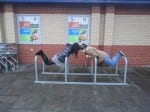After our trip to the grandstand it made me realise that it is one of the first things people see as they drive into Lincoln. The race course and stands of the Lincoln Handicap are a part of Lincoln history. Knowing now that what we call the ‘grandstand’ used to go by the name of the ‘Tattersall stand’ brought me to think about the stand as a landmark and the idea of urban restoration. What was the reason for the demolition of the other two stands? Perhaps through the process of “demolition by neglect situations” ((Weiss, John M. (2012) “The Fitch Forum: Protecting Landmarks From Demolition by Neglect: New York City’ Experience , Widener Law Review, 2012/01/01, Vol: 18, p. 309.)). It stands strong that “more attention should be devoted to the mechanisms through which the city is perceived” ((Sainz, Maria Alvarez (2012) “(Re)Building an Image for a City: Is A Landmark Enough? Bilbao and the Guggenheim Museum, 10 Years Together”, Journal of Applied Social Psychology; Jan 2012, Vol. 42 Issue 1, p. 100-132.)). The grandstand is a part of the history of the city and should be treated that way. Currently the future of the grandstand is unclear, however, a restoration project could help to bring life back into the grandstand and create a focal point for the history that lies within the walls and grounds of the building.
 Author: Charlotte Restall
Author: Charlotte Restall
Investigation: Images of space.
Everyday spaces go unnoticed by the world. These unnoticed spaces show a “disquieting familiarity of the city” ((Certeau, Michel de (1988[1984]) The Practice of Everyday Life, trans. Steven Rendall, Berkeley, Calif. London : University of California Press. p. 96.)), they may be acknowledged for their existence and use but not used. It seems as though most people don’t have time to appreciate things for their potential and therefore “to walk is to lack a place” ((Certeau, Michel de (1988[1984]) The Practice of Everyday Life, trans. Steven Rendall, Berkeley, Calif. London : University of California Press. p. 103.)), this suggests ‘dead’ space between points. However, the space you use while walking could be interacted with. For example: a hallway between rooms where it’s function serves to connect two or more rooms. By exploring these sorts of unnoticed spaces in different ways it creates a new meaning for them. As a task we were able to give a new use for these spaces then use free writing to create a response to the site.
http://www.youtube.com/watch?v=R2t9gIuDH7I
Free writing in response to image:

Lonely. Alone. Stillness like a button. Chosen. Choice. Decaying city. Metal ice cold hard shiny surface. The coldness burns. Ache, torn between metal and flesh. Symmetrical symmetry Mirror image of a lifeless face. Mirror. Cold and empty like a grave. Stillness in death. Death. Dead. Dead cold icy stare searing into a heart. Heart beating strong, death. Stop. Dead. Cold. Ice. Bitter face.